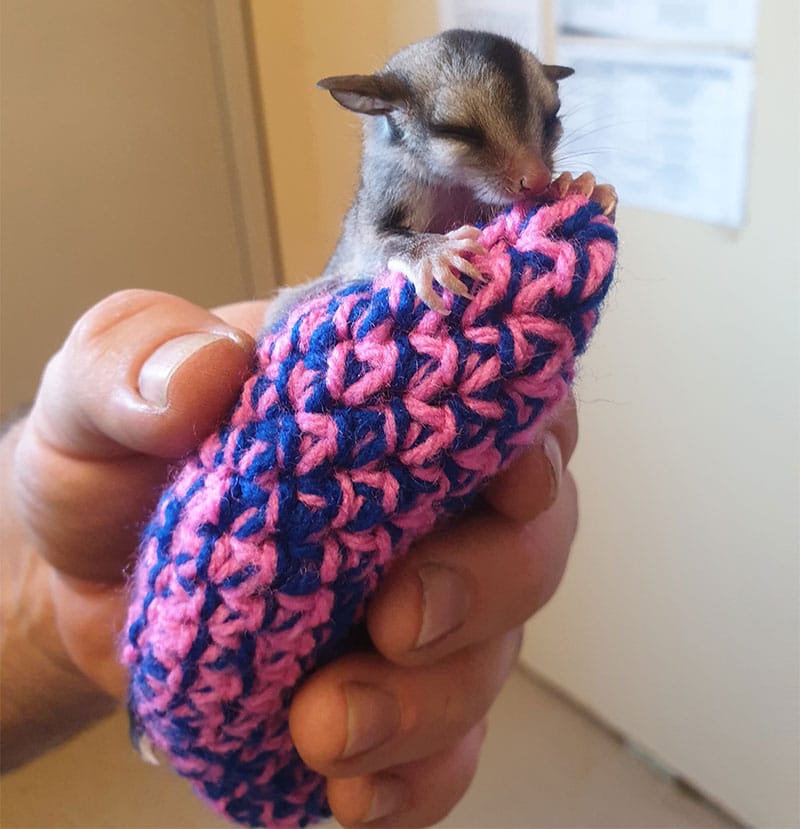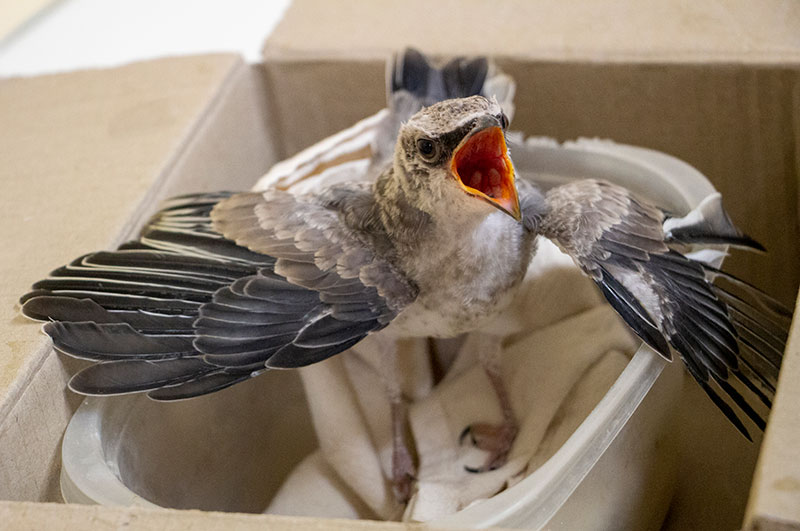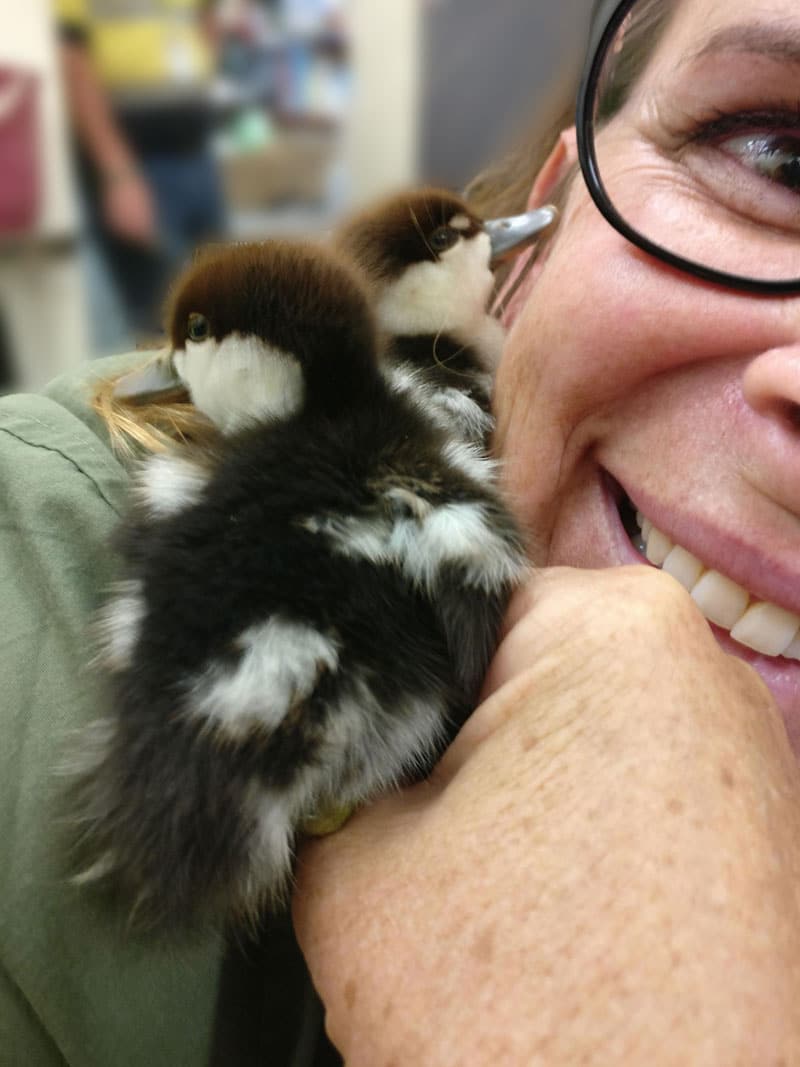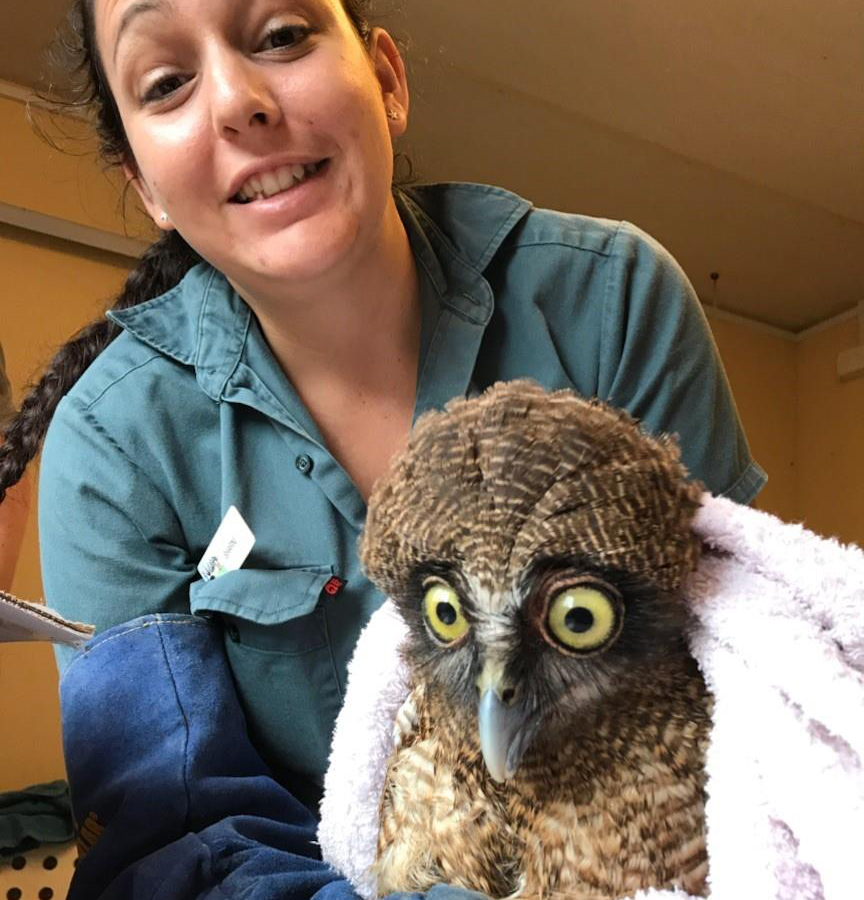Locally owned and operated by the CaPTA Group, the Wildlife Habitat is committed to the conservation of native species via the Tropical Animal Rehabilitation Centre, a non-profit facility that cares for sick, injured, displaced or orphaned native Australian Wildlife.
In addition to your visit to the wildlife park, you can go behind the scenes and see the ongoing work involved in caring for injured, orphaned and sick animals. Each month we receive numerous animals that we look after in the care centre, and out of those patients we will pick one to be the patient of the month! Click on the months below to check out the patient of that month!
March 2020: Sugar Glider
This little baby Sugar Glider was handed into the Tropical Animal Rehabilitation Centre. The concerned member of public that handed it in believes that Mum had become a victim to heat stress and that this little baby was suffering from dehydration.
After fluids and stabilisation in our clinic, the baby Sugar Glider was passed on to a specialised carer. Did you know that baby Sugar Gliders are called joeys?”

February 2020: Baby Finches
These tiny baby finches were brought into TARC after being found orphaned.
These finches are being fed a specialised grain based replacement food every 2 hours. We know when they have had enough as their crops can be seen swelling out like a little yellow bubble on the side of their necks.
This processes the food through to the digestive tract and once it is completely empty, the tiny chicks will be ready for more food!
The yellow lines in their mouth are often distinct to species and assist the parents to see where their mouths are when they enter their dark tiny nests.
January 2020: Spectacled Flying Fox
This sweet baby Spectacled Flying Fox, Minnie, spent the night in the Tropical Animal Rehabilitation Centre to recover.
We wrapped her up snug as a bug, gave her vital fluids and a dummy. After some much needed rest she went to a qualified bat handler for further care.

November 2019: Black Faced Cuckoo Shrike
This Black Faced Cuckoo Shrike was rescued from the wild after he was abandoned by his parents. He will be released back into the wild when he is ready.

Watch this little Black Faced Cucktoo Shrike demand his dinner below:
[divider width=”full”]
October 2019: Eclectus Parrot
Meet Dougie! This adorable baby Eclectus Parrot is two months old. Unfortunately, this feathery fella was rejected by his mother, who lives in Wildlife Habitat. Luckily, our wildlife keeper Holly stepped in as surrogate and has been hand-raising him ever since.
Once our brand new Rainforest Habitat is completed, lucky Dougie will be released into this tropical haven as a free-flying bird.

[divider width=”full”]
September 2019: Baby Curlew
This fluffy little baby Bush Stone Curlew was found abandoned by a member of the public at Old Forestry Road. The good Samaritan brought him into the TARC care centre, where he has since enjoyed snuggling his plush koala!
He is currently being fed mealworms and insects and will be released into the wild once he is old enough.

[divider width=”full”]
August 2019: Spotted-Tail Quoll
This elusive Spotted-tail Quoll (Dasyurus maculatus) was brought to TARC after being found quite stunned in a Port Douglas shop.
After an overnight stay and observation, he was on-the-mend and ready for a successful release.
We love these animals, they are absolutely fascinating; but unfortunately they are endangered, largely due to restrictive habitat.
Spotted-tail Quolls have cute pink noses, white spots all over their bodies (including their tails) and a tenacious personality.
Farewell little guy, stay safe!
[divider width=”full”]
July 2019: Fawn-Footed Melomy
This tiny Fawn-Footed Melomy was unfortunately found orphaned by a member of the public. The little guy was handed into the safe care of the Tropical Animal Rehabilitation Centre, where he is being intensively cared for by our dedicated wildlife keepers.
This Melomy is only a couple of weeks old, so it needs to be fed supplement food every couple of hours. This little mammal will be hand-raised by our wildlife keepers and will hopefully be released back into the wild.

[divider width=”full”]
June 2019: Echidna
This adorable young echidna was rescued from the wild in Port Douglas and was brought into TARC. Unfortunately, he had severe lacerations to both of his back feet and was in need of immediate veterinary treatment.
After a successful trip to the vets, this little guy is now in the loving care of a wildlife carer. We hope that he can eventually be released back into the wild.

[divider width=”full”]
May 2019: Spotted Nightjar
This Spotted Nightjar was found in Miallo on the side of the road with an injured wing. Sadly, our keepers think that he could have been hit by a car. The sweet bird was treated by vets at Boongarry and remains under the loving care of our team in the TARC care centre.
If his wing heals and he is able to fly properly, he may be a candidate for wild release. If not, he may remain in captivity.
For now, he’s recovering well at TARC and has just come off his pain relief. His wing strapping will be removed in 2 weeks and our keepers will re-evaluate his progress in 4 weeks. Fingers crossed for full recovery for this little guy!

[divider width=”full”]
April 2019: Laughing Kookaburra
This beautiful Lauging Kookaburra has sustained injuries that have left him with only one eye and an injured beak.
After being rescued on the Atherton Tablelands, he was taken into the care of a wildlife keeper before being brought to Wildlife Habitat around three weeks ago.
His eye socket needs to be flushed three times a day and will be closely monitored for progress.
Unfortunately, his single eye makes it unlikely for him to survive in the wild, so he is likely to remain in captivity.
[divider width=”full”]
Febuary 2019: Magpie Gosling
Nibbles the Magpie Gosling was brought into TARC after being found on a construction site in Port Douglas. Unfortunately, the little guy is having trouble walking, so we suspect that he may have been left behind by his parents. We will continue to monitor him and his locomotion over the next few days to determine what the problem is.
Nibbles will be remaining in the TARC Care Centre for 3-4 months before he is old enough to be fit for wild release.
The Magpie Goose (Anseranas semipalmata) is a common waterbird widely spread throughout Northern and Coastal Australia. They can be found in wetland areas along the coast from Western Australia to Rockhampton, Queensland.
These waterbirds congregate in large, noisy flocks, often consisting of thousands of birds. They are distinguished by their black and white colouring and characteristic knob on their crowns. Interestingly, their feet are only half webbed!
[ux_slider timer=”4500″ arrows=”true” bullets=”true” auto_slide=”true” nav_color=”dark”]
[ux_banner bg= “https://www.wildlifehabitat.com.au/wp-content/uploads/2019/02/magpie-gosling-at-wildlife-habitat-port-douglas-care-centre-tarc.jpg” height=”600px” text_color=”light” text_align=”center” text_pos=”center” text_width=”70%” parallax_text=”0″ parallax=”0″ effect=””]
[/ux_banner]
[ux_banner bg= “https://www.wildlifehabitat.com.au/wp-content/uploads/2019/02/magpie-gosling-at-wildlife-habitat-port-douglas.jpg” height=”600px” text_color=”light” text_align=”center” text_pos=”center” text_width=”70%” parallax_text=”0″ parallax=”0″ effect=””]
[/ux_banner]
[/ux_slider]
[divider width=”full”]
January 2019: Pheasant Coucal
This adorable Pheasant Coucal (Centropus phasianinus) chick was brought into our care centre this month.
Pheasant Coucals are found around the Northern and Eastern Coast of Australia between Pilbara, Western Australia and the South- Eastern Coast of New South Wales. They dwell in dense vegetation such as sugar cane, open forests and woodlands and around wet lands. In Tropical North Queensland, these birds are frequently seen on the side of the road and will fly into cane fields and scrub when disturbed. These ground-dwellers enjoy munching on small frogs, lizards, mice, insects and crabs.
These birds breed twice a season and often have two nests and two clutches of eggs at one time. The chicks from the first clutch are often kicked out of home before the second clutch are very old.

[divider width=”full”]
December 2018: Nail Tail Wallaby Joey
Little Matilda the Nail Tail Wallaby is being hand raised by one of our Wildlife Keepers. She has recently been weaned off milk and enjoys supervised play time outdoors. But her favourite hobby of all is relaxing in her makeshift pouch!
She will eventually join the rest of our Nail Tail Wallabies in the Savannah Habitat.

[divider width=”full”]
November 2018: Brahminy Kite
This little Brahminy Kite was brought into TARC after he was found fallen from the nest. Unfortunately, his nest was out of reach, so our Head Wildlife Keeper Bec tried to set up a man made nest for him in an adjacent tree. He kept jumping out, and as the nest was in dingo and pig territory, Bec thought it would be best to take him home overnight.
He enjoyed a feast of mice and fish for a couple of days at Bec’s home before returning to his original nest site. Our keepers had created a secure area for him and attempted to reunite him with his parents. Brahminy Kites have specialised hunting techniques that are learned.
The owners of the property proved themselves to be wildlife super heroes and fed him the provided food every day. Incredibly, his parents began dropping in rodents and snakes within two days.
This beautiful raptor fledged and has since been sighted on the ridge with his parents behind the original nest site. We do love a happy ending!
[ux_slider timer=”4500″ arrows=”true” bullets=”true” auto_slide=”true” nav_color=”dark”]
[ux_banner bg= “https://www.wildlifehabitat.com.au/wp-content/uploads/2018/11/brahminy-kite-at-wildlife-habitat-port-douglas-care-centre.jpg” height=”600px” text_color=”light” text_align=”center” text_pos=”center” text_width=”70%” parallax_text=”0″ parallax=”0″ effect=””]
[/ux_banner]
[ux_banner bg= “https://www.wildlifehabitat.com.au/wp-content/uploads/2018/11/rescue-brahminy-kite-wildlife-habitat-port-douglas.jpg” height=”600px” text_color=”light” text_align=”center” text_pos=”center” text_width=”70%” parallax_text=”0″ parallax=”0″ effect=””]
[/ux_banner]
[ux_banner bg= “https://www.wildlifehabitat.com.au/wp-content/uploads/2018/11/brahminy-kite-close-up.jpg” height=”600px” text_color=”light” text_align=”center” text_pos=”center” text_width=”70%” parallax_text=”0″ parallax=”0″ effect=””]
[/ux_banner]
[/ux_slider]
[divider width=”full”]
October 2018: Radjah Shelduck Ducklings
These oh-so-fluffy ducklings were brought into TARC after being found in Port Douglas. They were abandoned by their parents and brought in as “orphans”. When they arrived at the TARC, they still had their egg tooth, which meant that they had only hatched that day.
The ducklings have been passed into the loving care of our Head Wildlife Keeper Bec Lynch, who will hand raise them. They be released to the wild once they fledge, which is generally at around 50 days old.
The Radjah Shelduck (Tadorna radjah) is a protected species in all states of Australia. They can be found all across the coastal top of Australia, from Central Australia, right across the top of the Kimberleys in Western Australia. They are partial to Mangrove Flats and Wetland areas.
As fully grown adults, these ducks are mainly black and white with hints of chestnut, russet and green running across the chest and wings.
Although these fluffy ducklings no longer call Wildlife Habitat home, you can find Radjah Shelduck Ducklings in the Wetlands and Rainforest Habitats of the park. There are also some free roaming wild Radjah Shelducks in our Savannah Exhibit.

[divider width=”full”]
September 2018: Baby Sugar Gliders
These tiny sugar gliders were found by a Port Douglas local who rushed them into TARC and into the trusting hands of our wildlife keepers.
Hairless, weak and only the size of a peanut, these minuscule marsupials are some of the youngest animals ever brought into the Habitat’s Wildlife Care & Rescue Centre. The tiny sugar gliders may be very young, but our carers are hopeful that the gliders will survive with the correct intensive care.
The gliders are currently very small and underdeveloped but will soon begin to grow fur and open their eyes. In a few weeks these joeys would have been old enough to be left alone in the nest whilst their mother foraged for food.
The juvenile joeys have been sent to Boongarry Vet, where they will be hand raised. As with all animals brought to TARC, the intent is to release them back into the wild when they are old enough.

[divider width=”full”]
July 2018: Red Kangaroo Joey
Forget Wonder woman, the lady who rescued this little orphaned Red kangaroo joey is a real life superhero! After finding his mother dead at the side of the road in Normanton, Queensland, this wildlife hero checked the mothers pouch and found this little guy. Determined to help and travelling home to Newell beach, just north of Port Douglas, they headed back from the Gulf of Carpentaria to deliver this Red kangaroo joey to the TARC care centre ensuring he received the care needed to recover. This whopping 700 km drive saved this little guys life!
He arrived at TARC on the 17th of July . Our wildlife carers believe that he is around seven months old which means he will still require four specialised milk feeds a day at present, however should soon be eating grass and solids and be able to weaned from bottle feeds. He has been passed onto Boongarry veterinary clinic to receive a full health check. Once cleared and if determined to be in good health, he will be passed to a hero of another kind . A specialised carer will take him in, and he will continue to receive assistance until it is deemed he can survive on his own in the wild. If all goes well – he is a good candidate for wild release back to his home of Normanton in the gulf country.
[ux_slider timer=”4500″ arrows=”true” bullets=”true” auto_slide=”true” nav_color=”dark”]
[ux_banner bg= “https://www.wildlifehabitat.com.au/wp-content/uploads/2018/07/orphaned-red-kangaroo-joey-wildlife-care-centre-wildlife-habitat-port-douglas.jpg” height=”600px” text_color=”light” text_align=”center” text_pos=”center” text_width=”70%” parallax_text=”0″ parallax=”0″ effect=””]
[/ux_banner]
[ux_banner bg= “https://www.wildlifehabitat.com.au/wp-content/uploads/2018/07/red-kangaroo-joey-orphaned-wildlife-at-wildlife-habitat-port-douglas.jpg” height=”600px” text_color=”light” text_align=”center” text_pos=”center” text_width=”70%” parallax_text=”0″ parallax=”0″ effect=””]
[/ux_banner]
[ux_banner bg= “https://www.wildlifehabitat.com.au/wp-content/uploads/2018/07/adorable-baby-kangaroo-red-kangaroo-joey-orphaned-wildlife-port-douglas-wildlife-habitat.jpg” height=”600px” text_color=”light” text_align=”center” text_pos=”center” text_width=”70%” parallax_text=”0″ parallax=”0″ effect=””]
[/ux_banner]
[/ux_slider]
[divider width=”full”]
June 2018: Maple The Joey
Everyone meet Maple! Unfortunately her mum was hit by a car, but a passing motorist found Maple in her pouch. Maple briefly spent a couple of nights with us at the Wildlife Habitat Care Centre, and then was passed onto Amber Dahlberg, a highly experienced carer where she will stay until she’s all grown up!
We also received a little gift from the Amber, some much needed pouches and liners for rescues that come through the Care Centre!
Thank you to the good Samaritan that searched the mother’s pouch to check if there was a joey, this little one is saved because of you!

May 2018: Papuan Frogmouth
TARC is constantly receiving sick, injured and orphaned native animals found in the local area, and this adorable Papuan Frogmouth is one of our most recent patients. It is suspected that this fluff ball fell out of the nest prematurely and suffered several injuries. It was subsequently diagnosed with a shoulder soft tissue injury and a possible fracture.
Held in our onsite care centre and initially treated by our Vet whilst receiving ongoing care from the Wildlife team, its fractures have been treated and it has recovered well. Even though the injuries have healed there is always a risk with these types of issues that the bird may not fly well enough to be able to hunt properly in the wild on its own. This could potentially mean that this animal may not be able to be wild released. In a situation such as this, the decision is made by the treating veterinarian once the course of treatment is finalised , whether the bird is suitable for wild release or will be held in care permanently
In the meantime, it is receiving daily treatment and nurturing from our team to strengthen it up to give it every chance to be a successful wild release animal.
[ux_slider timer=”4500″ arrows=”true” bullets=”true” auto_slide=”true” nav_color=”dark”]
[ux_banner bg=”https://www.wildlifehabitat.com.au/wp-content/uploads/2018/05/3E59258E-0586-4C6B-92AC-382886CA8314.jpg” height=”600px” text_color=”light” text_align=”center” text_pos=”center” text_width=”70%” parallax_text=”0″ parallax=”0″ effect=””]
[/ux_banner]
[ux_banner bg=”https://www.wildlifehabitat.com.au/wp-content/uploads/2018/05/25999F1F-4763-40D7-96C1-78D91934B072.jpg” height=”400px” text_color=”light” text_align=”center” text_pos=”center” text_width=”70%” parallax_text=”0″ parallax=”0″ effect=””]
[/ux_banner]
[ux_banner bg=”https://www.wildlifehabitat.com.au/wp-content/uploads/2018/05/34119484_10215773966842809_3130182099584155648_n.jpg” height=”400px” text_color=”light” text_align=”center” text_pos=”center” text_width=”70%” parallax_text=”0″ parallax=”0″ effect=””]
[/ux_banner]
[ux_banner bg=”https://www.wildlifehabitat.com.au/wp-content/uploads/2018/05/33992886_10215773967362822_1613638128143171584_n.jpg” height=”400px” text_color=”light” text_align=”center” text_pos=”center” text_width=”70%” parallax_text=”0″ parallax=”0″ effect=””]
[/ux_banner]
[/ux_slider][divider width=”full”]
April 2018: Rufous Owl
A lovely local couple saw this poor little Rufous Owl in a bad way, so they brought him to us for a check!
The Rufous Owl is found in Northern Australia stretching between WA, the Kimberley Region to Rockhampton and also New Guinea.
As there was no breaks or obvious injury, we took him in to the vet for a thorough check. The vet believes it received a nasty concussion but has recovered well overnight.
He has been flight tested and has been cleared for release. Depending on the weather we hope to release him/her a within the next 48 hours.

March 2018: White-breasted woodswallow
This cute little White-breasted woodswallow was brought in as a small chick after it was suspected he was knocked out of a nest. He has now lost all chick feathers and growing into his adult plumage. White-breasted woodswallows are highly sociable and are often found in small flocks, sometimes reaching groups of around 50. They are aerial feeders, catching small insects on the wing as they fly over water or land. We are hoping this little bird is not too far off catching insects of his own when he is released after “flight training”
Although this little guy is in the Care Centre, you can come and have a look at this species within our Woodlands environment and even ask our friendly keepers for some fun facts!
[ux_slider timer=”4500″ arrows=”true” bullets=”true” auto_slide=”true” nav_color=”dark”]
[ux_banner bg=”https://www.wildlifehabitat.com.au/wp-content/uploads/2018/03/Wbreasted-Wswallow1.jpg” height=”600px” text_color=”light” text_align=”center” text_pos=”center” text_width=”70%” parallax_text=”0″ parallax=”0″ effect=””]
[/ux_banner]
[ux_banner bg=”https://www.wildlifehabitat.com.au/wp-content/uploads/2018/03/Wbreasted-Wswallow3.jpg.png” height=”400px” text_color=”light” text_align=”center” text_pos=”center” text_width=”70%” parallax_text=”0″ parallax=”0″ effect=””]
[/ux_banner]
[/ux_slider]
February 2018 : White-lipped tree frog
TARC really does care for all creatures great and small! This poor little fella was brought in with a laceration to his back-right leg. Fortunately, our dedicated keepers were able to treat the wound.
The White-lipped tree frog, also known as the giant tree frog and can grow up to 14cm making it Australia’s largest frog. They are well known in Cairns and surrounds and are often spotted in urban gardens or even in the house! Luckily, they are not dangerous and usually mind their own business.
The White-lipped tree frog eats things such as arthropods and insects. For this little fella, it will be 5-star service for the next couple of weeks with his meals being served up for him! All that is needed now is some rest and recovery and then he will be released back in to the wild.
[ux_slider timer=”4500″ arrows=”true” bullets=”true” auto_slide=”true” nav_color=”dark”]
[ux_banner bg=”https://www.wildlifehabitat.com.au/wp-content/uploads/2018/02/IMG_2879cropped.jpg” height=”600px” text_color=”light” text_align=”center” text_pos=”center” text_width=”70%” parallax_text=”0″ parallax=”0″ effect=””]
[/ux_banner]
[ux_banner bg=”https://www.wildlifehabitat.com.au/wp-content/uploads/2018/02/IMG_2877_cropped.jpg” height=”600px” text_color=”light” text_align=”center” text_pos=”center” text_width=”70%” parallax_text=”0″ parallax=”0″ effect=””]
[/ux_banner]
[ux_banner bg=”https://www.wildlifehabitat.com.au/wp-content/uploads/2018/02/IMG_2880cropped.jpg” height=”600px” text_color=”light” text_align=”center” text_pos=”center” text_width=”70%” parallax_text=”0″ parallax=”0″ effect=””]
[/ux_banner]
[/ux_slider]
January 2018 : Eastern Grey Kangaroo
This cute little Eastern Grey Kangaroo joey was brought into TARC on 21st October weighing around 1.2kg. Initially, she was being fed every four hours around the clock whilst she settled into her new surrounds. As she grew, her need for such regular milk feeds reduced but her quantity increased. Moving along, a big milestone for her, was her first hop, which was mid-November. Following that she started eating more solid foods and her milk was slowly reduced. Christina, the keeper who was looking after her was a very proud mum! The joey has now been sent to another carer, where she will have the opportunity to socialise with the other kangaroos, and then ultimately released back into the wild!
The Eastern Grey Kangaroos can grow to around 1.3 meters, and have a wide and almost continuous distribution between inland plains and the coast. These roos love resting in the shade or underneath some trees, avoiding the hottest parts of the day.
[ux_slider timer=”4500″ arrows=”true” bullets=”true” auto_slide=”true” nav_color=”dark”]
[ux_banner bg=”https://www.wildlifehabitat.com.au/wp-content/uploads/2018/01/IMG_2686.jpg” height=”500px” text_color=”light” text_align=”center” text_pos=”center” text_width=”70%” parallax_text=”0″ parallax=”0″ effect=””]
[/ux_banner]
[ux_banner bg=”https://www.wildlifehabitat.com.au/wp-content/uploads/2018/01/IMG_2690.jpg” height=”600px” text_color=”light” text_align=”center” text_pos=”center” text_width=”70%” parallax_text=”0″ parallax=”0″ effect=””]
[/ux_banner]
[ux_banner bg=”https://www.wildlifehabitat.com.au/wp-content/uploads/2018/01/IMG_2692.jpg” height=”500px” text_color=”light” text_align=”center” text_pos=”center” text_width=”70%” parallax_text=”0″ parallax=”0″ effect=””]
[/ux_banner]
[/ux_slider]








